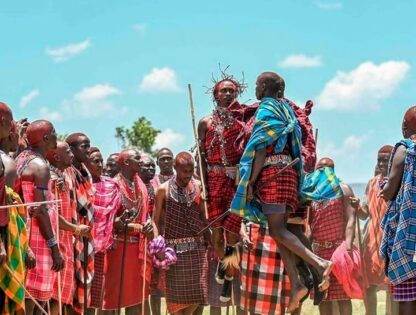The Maasai are the most well-known conventional, native ethnic group in Kenya and Tanzania, having a population of about 650,000. They may be semi-nomadic pastoralists of Nilotic sources resisting change and holding onto their culture. Sociolinguistic research indicates that their sources have been stretching in the 15th century and in North Africa, and reaching Tanzania. They settled to Dodoma, particularly from Mt Marsabit through the entire raid areas of the Rift Valley. You’ll find fourteen independent Maasai tribal groups usually speak language, and like the Kisongo as well as the Punko, Loita and Matapato of Kenya.
The Maasai are readily recognisable by colourful attire and their scenic height. Traditionally leather cloaks were worn by them but now they wear orange, blue or red striped or checked blankets or sheets (shuka) wrapped around their bodies. Kenyan Maasai girls and Tanzanian Maasai girls wear colourful bead necklaces, bracelets and earrings and white beads, respectively. Copper bangles are also worn by a few of the men. Women and men elongate their ear lobes. As kids their ear lobes are pierced as well as the hole kept by the insertion. Children often wear sandals as well as the men take a big, sheathed knife a wooden weapon; as well as a walking stick.
The Maasai diet includes blood, and milk meat. Blood is generally drunk and is blended. Government sanctioned long-term settlements are being led to by limits for their nomadic lifestyles, plus they’ve begun to grow crops like beans, maize, rice, potatoes and cabbages. Cows are fundamental to their own tradition and are a sign of standing and wealth. Cows are useful for commerce, household goods, and are the primary revenue stream to cover other as well as schooling expenses. The more cows a person gets the more girls he is able to marry. They go seasonally to productive grazing land, and also keep sheep, goats, donkeys and chickens. The Maasai don’t eat creatures that are wild living in harmony by making use of their surroundings. But a conventional evaluation was the effort of killing a lion single handed.
The men compete in leaping dances joined with chanting. The higher the more desirable can be jumped by a guy he’s to the girls. The Maasai are polygamists just wedding into other Maasai families. They live in kraals with numerous houses (boma) for every one of extended family and their wives. Boma are made by girls from sticks, mud, straw, cow dung and pee. Kraals are surrounded by fencing built by the men using sticks or Acacia thorn bushes to keep out trespassers and predators. Girls are in charge of domestic jobs including gathering firewood, roots and berries and the building.
The Hadza people, also called the Hadzabe Bushmen (plural form), are among the last hunter-gatherer tribes left in the planet these days. Just 300400 of those live traditionally. They’ve no connection that is recorded to another ethnic group, but research indicates that they strongly resemble the Pygmies.
The Hadza live around Lake Eyasi in north central Tanzania and also in the neighboring Serengeti Plateau. They’ve four conventional dry season habitats; west of the southern end between the Yaeda Valley as well as Lake Eyasi; east of the Yaeda Valley and north around Mang’ola town of the valley. Their western habitats are accessed by them by crossing the escarpment of Serengeti Plateau close to the northern coast, and crossing the southern area when it’s dry. Between these zones or hunt they reside, hunt and forage throughout the wet season. The Hadza are exempt although the Tanzanian government has prohibited hunting. The Datoga has taken over a few of the land, minimizing use of food.
The Hadza men have begun to make use of hunting dogs and hunt using strong bows and arrows. Men and the women forage in groups for pulp and berries from tubers baobab trees and honey. Their diets vary based on availability. Their diets consist primarily of some berries and honey and tubers, with match in the very least.
Apparel includes leather garments. Married women also put on a fabric garment decorated.
Hadza society is free and egalitarian of possession and private property. They practice patriarchal monogamists where they do not marry into other ethnic groups and permit divorce. The Hadzabe are joyful, peaceful, conciliatory, carefree and battle-avoidant.
The Barbaig, also known as Barbaiq or Barabaig, are the largest sub-tribe of the Datoga pastoralists of north-central Tanzania, numbering around 30,000. Their language bears a Nilotic resemblance to the Eastern Sudanic language group. They have lived predominantly in the northern volcanic highlands of Mt Hanang for the past 150 years, but also occupy land around Lake Eyasi and Makuyuni town.
In the 1960s a take-over of their lands by the Tanzania-Canada Wheat Project forcibly evicted them from their customary lands on the fertile Basotu Plains of Mt Hanang district, which has since left them displaced. Tensions erupted between the Barbaig and the Tanzanian government resulting in land dispossession, further displacement and social dislocation of their social roots and customs.
The culture of the Barabaigis is similar to that of the Maasai, but usually wear red or blue checked or striped blankets (shuka), women’s wraps (kanga and Kitana) or Western clothing. They elongate their ear lobes and tattoo their faces in the same manner and wear hand-welded brass and aluminium bangles and necklaces.
The Barbaig also keep cows, sheep, goats, donkeys and chickens in a cattle corral, and subsist on a diet of milk, blood, meat, maize and beans. Like the Datoga and Maasai their ceremonial dance centres on jumping competitions and chanting.
The Datoga are semi-nomadic pastoralists of Southern Nilotic sources living mainly in the dry parts of Manyara and Singida in north-central Tanzania, inhabiting places around Lake Eyasi, Lake Basotu and Mt Hanang. Sociolinguistic research indicates that their sources have been in the western Ethiopian highlands or Southern Sudan for about 3000 years past. Dialects are spoken by the Datoga in the Southern Nilotic language family. The language of the Cushitic agricultural neighbours Iraqw, is also spoken by 20%. Over 50% talk Barabaig, some about 1% talk Swahili and talk Maasai.
The Datoga are also understood by Datooga the Sakuma name of Taturu; Tatooga as well as Mangati’s Maasai name. The primary sub-tribe is the Barabaig (additionally Barbaiq), an option name used to describe them.
The Datoga possess a reputation as ferocious warriors, as well as the Maasai are their enemies that are conventional yet they share similar customs and apparel. Using being understood than the famed Maasai pastoralists and a smaller existence, their people is less than 100,000. The girls rust or conventional wear clay-coloured leather skirts (hanangwend) and leather cape created from impala calf, goat and sheep skin softened with pee, fringed, and dyed using red ochre. Both women and men wear hand-welded aluminium and brass bangles, necklaces and earrings. The men and women wear colourful beads and elongate their ear lobes. A few of the men, especially the older generations and the girls, tattoo their faces. Girls generally have little wounds in a wide semicircle in the skin and cheeks.
The Datoga live in monogamous homesteads and are sparsely arrayed. Thorn bushes surround a gheid to keep out trespassers and predators. Their huts are produced from cow dung, straw, sticks and mud. Their diets consist primarily of meat, milk and blood, but blood is sometimes blended and normally drunk with milk. As a result of an increasingly sedentary lifestyle, they cultivate several crops including beans, millet and maize. Cows are fundamental to their own culture, and will be the mainstay of the subsistence, supplying meat and blood; horns for devices and receptacles; leather kitchen home goods; and clothing. Significantly, cows really are a status symbol. A man is able to marry the more cows he possesses his so-called wealth and standing as well as the more girls to the greater. The men enter into jumping contests where those that will leap the highest are more desirable to the girls.








